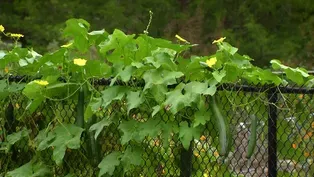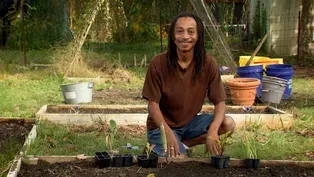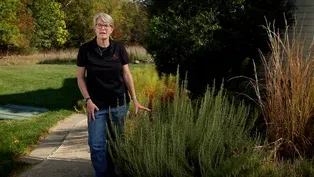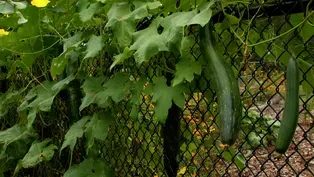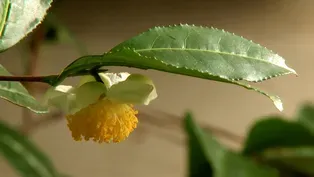Virginia Home Grown
Making a Perfect Pot of Tea
Clip: Season 23 Episode 8 | 5m 37sVideo has Closed Captions
Discover tips to brew tea perfectly
Mark Ragland shares tips for brewing tea including what water to use, timing and temperature. Featured on VHG episode 2308; October 2023.
Problems with Closed Captions? Closed Captioning Feedback
Problems with Closed Captions? Closed Captioning Feedback
Virginia Home Grown is a local public television program presented by VPM
Virginia Home Grown
Making a Perfect Pot of Tea
Clip: Season 23 Episode 8 | 5m 37sVideo has Closed Captions
Mark Ragland shares tips for brewing tea including what water to use, timing and temperature. Featured on VHG episode 2308; October 2023.
Problems with Closed Captions? Closed Captioning Feedback
How to Watch Virginia Home Grown
Virginia Home Grown is available to stream on pbs.org and the free PBS App, available on iPhone, Apple TV, Android TV, Android smartphones, Amazon Fire TV, Amazon Fire Tablet, Roku, Samsung Smart TV, and Vizio.
Providing Support for PBS.org
Learn Moreabout PBS online sponsorshipWell, Mark, I'll be honest with you.
This smells delicious in here.
All these aromas of these teas and you know, where do we begin 'cause I just take the water, pour it on the tea, let it, go do something, come back and then I drink it and I don't think that's what your intent is.
>>Well, tonight we're gonna learn to make the perfect pot of tea.
Not just a pot of tea, but the perfect one.
>>Okay.
>>In a truncated way.
>>Okay.
(both laugh) >>All right, so what do you think the most important ingredient is to start with?
>>Well, the tea.
>>Well, you would think that, but actually your water source is.
If you don't like the taste of your water, there's a good chance your tea's not gonna taste that good and a lot of people make that mistake.
So I'm lucky to have the well water, so it's not so bad for me, but make sure you get a good source of water 'cause that's your main ingredient.
And tea will adapt to that flavor, so you wanna make sure it's good.
>>That makes sense.
It makes perfect sense.
>>Then you're gonna need to wait to heat the water.
>>Right.
>>Because that's part of the process.
So I've got a handy-dandy water heater and you're gonna open it up with your good source of water.
>>Right.
>>Fill it to the appropriate amount for your pot.
>>Okay.
>>We'll skip the full amount of that.
>>Right.
>>And then you're gonna want to heat the water.
>>Well, to what temperature do you heat the water to?
>>Well, that's where the decision you're about to make, makes a big difference.
>>Okay.
>>So the next step in the process before we actually push the button, is to choose the tea we wanna make.
>>Huh, okay.
So what are my choices of tea to choose from?
>>Well, tonight I brought you just a couple.
There are lots to choose from.
>>Right.
>>I brought you some of my own brew.
This is tea I've made from my garden, so that's the oolong that I've made.
>>That's nice and coarse.
That's usually coarser than... >>Yeah, if you've got a bigger leaf, it gives a different type of flavor than if it's much finer, typically a better flavor.
>>Okay.
>>That's what's considered.
>>Alright.
>>And we've also got monkey picked.
>>Monkey picked?
Truly picked by monkeys?
>>Truly.
>>Okay, I trust you.
>>That's the idea.
At least it used to be.
>>Yep.
>>And then, we've got a wonderful tea from India, the Darjeeling tea.
>>Oh.
Oh, that smells wonderful, that's- >>Before you make your decision, keep in mind that we also have some herbs.
>>Yeah.
>>But remember what we've learned, if it's got tea, it's got to be Camellia sinensis.
>>Right.
>>To really be tea, it can't have the herbs because that's an infusion or a tisane.
>>Okay.
>>So you can blend the herbs with the tea and still be a tea.
>>But if we just wanna do these, like I've got the hibiscus, and we've got the rose hips- >>Right.
>>And we've got lavender.
>>Oh, my favorite.
>>They all make great tisanes or infusions by themselves.
>>Right.
>>So you've got those to choose from as well.
>>But we could add those as a flavor to the tea?
>>Equally.
>>Okay.
>>And still be great.
>>Okay, well I'm gonna choose a Darjeeling.
>>Ah, good choice.
>>Thank you.
>>All right, so the next thing we wanna do- >>Is, I'll tell you what.
>>Is start the water up.
And because this is a black tea, that's gonna need full heating.
We want to heat the water to boiling.
So a good water heater's gonna give you different choices for different temperatures.
If it's a green tea, you don't wanna boil it.
'cause that'll scald the tea.
If it's an oolong, you want it to just about boil, so there's bubbles on the edge of the pot right before it boils.
>>Right.
>>That's the point.
And for black tea, you wanna boil.
Cold water to start with, push the button and let it start heating.
>>All righty.
>>Now we gotta get the tea ready to go in the pot.
>>Okay.
>>So I've got a handy dandy tea ball here.
>>Well, how much do we put in the tea ball?
>>Ah, that matters too.
>>Okay.
>>So, typically, for a teapot of this size, which is a four cupper- >>Okay.
>>You want two heaping teaspoons.
>>All righty.
>>So I'm gonna put two in and you'll see what that looks like.
It's not quite full.
However, I know you and I prefer a stronger cup of tea.
>>We do like the tea stronger.
>>A good brew.
So I'm gonna put an extra spoonful in.
A lot of people say an extra spoon for the pot anyway.
>>Right.
Okay.
>>The key is you don't want to overfill it and go above the middle of the tea ball.
>>Why not?
>>It needs room to expand, especially with a larger leaf tea, the better teas, they need room to grow in the tea ball and dance around and do what they do as they infuse.
>>These are dehydrated leaves.
You're right.
Mm-hmm.
>>So you'll take your tea ball and get it in the pot and get it ready.
(teapot clangs) Now, through the magic of time- >>Yes.
>>The water is ready.
You heard this ding.
>>Bingo.
>>And it's boiling.
>>I did hear a ding, yes.
(both laugh) >>Now, we wouldn't have normally put the tea in.
You were supposed to catch me on that.
>>Oh, I'm so sorry.
>>Gosh, Peggy.
>>Oh, I blew it.
>>So before the tea goes in, what you really need to do is heat the teapot.
>>I've never done that.
>>Because the teapot's cold.
And if you don't, that temperature you're trying to get with the water, it instantly goes down because the teapot cools it down.
>>And it's all about the water.
>>It is, so pour a little hot water in, warm up the teapot, spill it out.
Then you put your tea in and now you can add your water.
>>Okay, well- >>And let it- >>I like our invisible water.
>>Let it steep.
>>So how long do we let it steep?
>>Again, the decision you made affects that length of time.
And I've got this handy dandy timer that has three different timers for different types of tea.
Nicely, it's color coded.
>>Yes.
>>So green for green tea, which is gonna be three minutes.
It's less time.
It's a fragile tea.
It doesn't need as long to steep.
A lot of times you will re steep a green tea.
>>Yes, up to three times.
>>Yellow for yellow teas or oolong teas, and black for black teas.
>>Sounds great.
>>So we turn that over and we let it wait, five minutes in this case, and our tea is brewing to a perfect cup.
>>Sounds great, which we have just one minute left.
>>So, I've already made a pot of the tea you happened to select.
>>Yes.
I am a magician at heart, so I- >>You are a magician.
>>I guessed ahead.
>>Would you like me to pour?
>>I would love a cup of tea.
>>That's a nice, rich, beautiful cup of tea there, Mark.
>>Yeah.
>>Absolutely beautiful.
Well, tell me, what do you do with the pot once you're through?
>>So it's important too, to keep that tea warm because we all wanna enjoy it at the nice temperature we've gotten it to, and that's where tea cozies come in handy.
You can just throw one of those over.
I saw you pull one off.
>>Mm-hmm.
>>But that'll keep the pot warm for hours.
Amazingly, a good tea cozy will do that.
>>So I don't have to worry about making it immediately and serving it.
I could make it ahead.
>>You can make it ahead >>And then enjoy.
Let it stay hot and then I can serve it to my guests.
>>Exactly.
>>Or myself, even.
And have more than one cup.
>>Exactly.
>>Well, Mark, this has been enlightening.
You know, we always thought, well, I always thought it was the tea, but it's the water and it's the source of the water, the temperature of the water, as well as the steeping time.
And this has been very enlightening.
Thank you.
>>Great.
I'm glad you enjoyed it.
>>Yes.
Truly appreciate it.
Video has Closed Captions
Learn how to grow tea trees and luffa plants! (26m 46s)
Video has Closed Captions
Add interest to landscape beds by using herbs (2m 44s)
Video has Closed Captions
Discover how luffa plants are grown to make natural sponges! (7m 34s)
Natural Sponges made from Luffa
Video has Closed Captions
Learn how the luffa plant is processed to make a sponge (6m 34s)
Providing Support for PBS.org
Learn Moreabout PBS online sponsorshipSupport for PBS provided by:
Virginia Home Grown is a local public television program presented by VPM
